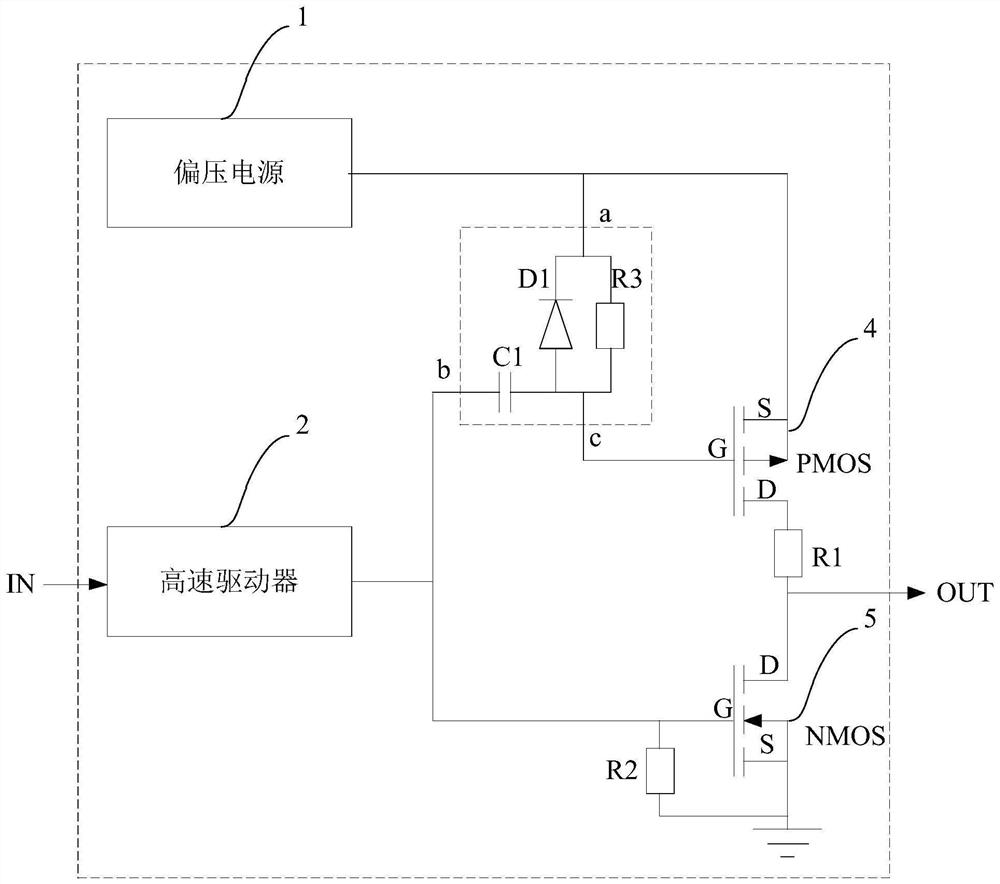Quenching and restoring circuit of silicon-based single-photon detector and control method of quenching and restoring circuit
A single-photon detector and recovery circuit technology, applied in the field of photodetectors, can solve problems such as large RC time constants that cannot be satisfied at the same time, low counting rate of silicon-based single-photon detectors, MOSFET damage, etc., to achieve short turn-on and turn-off time, low quiescent power consumption, and the effect of fast switching speed
- Summary
- Abstract
- Description
- Claims
- Application Information
AI Technical Summary
Problems solved by technology
Method used
Image
Examples
Embodiment 1
[0035] Such as figure 1 As shown, it is a schematic circuit diagram of a quenching and recovery circuit of a silicon-based single photon detector in this embodiment. The quenching and recovery circuit of the silicon-based single-photon detector in this embodiment is used to generate a large voltage pulse signal with a high voltage amplitude. The silicon-based single-photon detector has a total input terminal IN and a total output terminal OUT, so The total input terminal IN is used to receive a preset pulse, and the total output terminal OUT is used to provide the large voltage pulse signal to improve the detection efficiency of the silicon-based single photon detector.
[0036] The quenching and recovery circuit of the silicon-based single photon detector of this embodiment includes a bias power supply 1 , a high-speed driver 2 , a negative deviation clamping sub-circuit 3 , a PMOS transistor 4 and an NMOS transistor 5 . Specifically, the input terminal of the high-speed dri...
Embodiment 2
[0043] Such as figure 2 As shown, it is a circuit schematic diagram of a silicon-based single photon quenching and recovery circuit in the embodiment of this city. This embodiment includes a bias power supply 1 , a high-speed driver 2 , a negative deviation clamping sub-circuit 3 , a PMOS transistor 4 and an NMOS transistor 5 with the same or similar structure and function as that of the first embodiment. The difference of this embodiment is that the silicon-based single-photon quenching and recovery circuit of this embodiment is mainly used for quenching the avalanche signal and restoring the bias voltage of the silicon-based single-photon detector in the gating mode. details as follows:
[0044] This embodiment also includes a high voltage power supply 6, a fourth resistor R4, a silicon-based single photon detector 7, a signal source 8 and a second capacitor C2. Specifically, the output end of the high-voltage power supply 6 is electrically connected to the N pole of the ...
Embodiment 3
[0048] Such as Figure 4 Shown is a circuit schematic diagram of a silicon-based single-photon quenching and recovery circuit of this embodiment. This embodiment includes a bias power supply 1 , a high-speed driver 2 , a negative deviation clamping sub-circuit 3 , a PMOS transistor 4 and an NMOS transistor 5 with the same or similar structure and function as that of the first embodiment. The difference of this embodiment is that the silicon-based single-photon quenching and recovery circuit of this embodiment is mainly used for quenching the avalanche signal and recovering the bias voltage of the silicon-based single-photon detector in active mode. details as follows:
[0049] This embodiment also includes a high voltage power supply 6, a fourth resistor R4, a silicon-based single photon detector 7, an avalanche signal detection and feedback sub-circuit 9 and a third capacitor C3. Specifically, the output end of the high-voltage power supply 6 is electrically connected to th...
PUM
 Login to View More
Login to View More Abstract
Description
Claims
Application Information
 Login to View More
Login to View More - R&D
- Intellectual Property
- Life Sciences
- Materials
- Tech Scout
- Unparalleled Data Quality
- Higher Quality Content
- 60% Fewer Hallucinations
Browse by: Latest US Patents, China's latest patents, Technical Efficacy Thesaurus, Application Domain, Technology Topic, Popular Technical Reports.
© 2025 PatSnap. All rights reserved.Legal|Privacy policy|Modern Slavery Act Transparency Statement|Sitemap|About US| Contact US: help@patsnap.com



